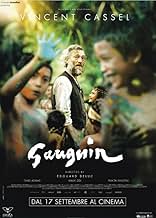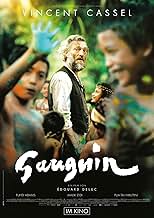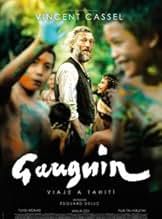NOTE IMDb
6,0/10
2,5 k
MA NOTE
La liaison du peintre français Paul Gauguin avec une jeune fille à Tahiti.La liaison du peintre français Paul Gauguin avec une jeune fille à Tahiti.La liaison du peintre français Paul Gauguin avec une jeune fille à Tahiti.
- Réalisation
- Scénario
- Casting principal
Teiva Monoi
- Onati
- (as Teiva Manoi)
Avis à la une
This film fails in every possible way. Even the cinematography manages to flatten the lushness of Tahiti. But the story line is worse.
One has to wonder how and why it is near impossible for modern people to reconcile that Gauguin can be both a despicable pedophile and a great artist? I guess this is the fruit of ever decreasing interest in the classics, where literature for 3,000 years did not have the difficulty we have today in portraying real or archetypical legendary persons as both great personages and contemptible.
Consider that the entire film fails to mention, even once, this "wife" was 13 years old. That his relationship with her, and the natives, is a refection of his own selfish and predatory individual colonialism. Even his abandonment of his wife and children in France, attested to as abandonment in the sourced biographies, is inverted into them not wanting to come with him.
One has to wonder how and why it is near impossible for modern people to reconcile that Gauguin can be both a despicable pedophile and a great artist? I guess this is the fruit of ever decreasing interest in the classics, where literature for 3,000 years did not have the difficulty we have today in portraying real or archetypical legendary persons as both great personages and contemptible.
Consider that the entire film fails to mention, even once, this "wife" was 13 years old. That his relationship with her, and the natives, is a refection of his own selfish and predatory individual colonialism. Even his abandonment of his wife and children in France, attested to as abandonment in the sourced biographies, is inverted into them not wanting to come with him.
The story is simply flat and boring. There's no climactic moments, only perpetual dullness. Even the locations of the films do not seem beautiful, which does not do Tahiti justice. It isn't enticing to look at a very unkempt protagonist either. I was thoroughly bored by this film.
Paul Gauguin (Vincent Cassel) feels smothered by the atmosphere prevailing in Paris in the year 1891. Around him, everything is so artificial and conventional: he needs authenticity to renew his art. Failing to convince his wife Mette Gauguin (Pernille Bergendorff) and his five children to follow him to Paradise Lost. As Gauguin married in 1873 a Danish woman, Mette-Sophie Gad (1850-1920). Over the next ten years, they had five children: Émile (1874-1955); Aline ; Clovis ; Jean René ; and Paul Rollon . By 1884, Gauguin had moved with his family to Copenhagen, Denmark, where he pursued a business career as a tarpaulin salesman. It was not a success: He could not speak Danish, and the Danes did not want French tarpaulins. Mette became the chief breadwinner, giving French lessons to trainee diplomats. His middle-class family and marriage fell apart after 11 years when Gauguin was driven to paint full-time. He returned to Paris in 1885, after his wife and her family asked him to leave because he had renounced the values they shared. Gauguin's last physical contact with them was in 1891, and Mette eventually broke with him . Then Paul Gauguin sets out for Tahiti alone. Once there, he chooses to settle down in Mataiera, a village far away from Papeete, installing himself in a native-made hut. . During his two-year stay the artist will experience poverty, cardiac problems and other displeasures but also happiness in the arms of Tehura (Tuheï Adams) , a beautiful young native girl . The journey begins !
The film relies heavily on Gauguin's stay in Tahiti where he soon starts working passionately, painting and carving in a style close to the primitive art specific to the island, but turning out to be somewhat boring and tiresome . Exploring the relationships with his lover, at the time a minor, as well as his relationships with the natives and other people of Tahiti. The film , well played by Vincent Cassel, results to be slow and dull , without much interest due to be really focused on French painter Paul Gauguin's affair with a younger lady in Tahiti , being only for biography enthusiasts and lovers of impressionist paintings . There is also a study of the artist's creative process and how he savors the Tahiti environment and later reflects it in his paintings. The motion picture was middlingly directed by Edouard Deluc.
Being well based on facts : Eugène Henri Paul Gauguin (1848 -1903) was a French Post-Impressionist artist. Unappreciated until after his death, Gauguin is now recognized for his experimental use of colour and Synthetist style that were distinct from Impressionism. Toward the end of his life, he spent ten years in French Polynesia. The paintings from this time depict people or landscapes from that region. His work was influential on the French avant-garde and many modern artists, such as Pablo Picasso and Henri Matisse, and he is well known for his relationship with Vincent and Theo van Gogh. Gauguin's art became popular after his death, partially from the efforts of dealer Ambroise Vollard, who organized exhibitions of his work late in his career and assisted in organizing two important posthumous exhibitions in Paris. Gauguin was an important figure in the Symbolist movement as a painter, sculptor, printmaker, ceramist, and writer. His expression of the inherent meaning of the subjects in his paintings, under the influence of the cloisonnist style, paved the way for Primitivism and the return to the pastoral. He was also an influential practitioner of wood engraving and woodcuts as art forms. In the 21st century, Gauguin's Primitivist representations of Polynesian cultures and peoples, the artist's sexual relationships with teenage Tahitian girls, and the legacy of European colonialism in his work have been a subject of renewed scholarly debate and controversy. Gauguin's Martinique paintings were exhibited at his colour merchant Arsène Poitier's gallery. There they were seen and admired by Vincent van Gogh and his art dealer brother Theo, whose firm Goupil & Cie had dealings with Portier. Theo purchased three of Gauguin's paintings for 900 francs and arranged to have them hung at Goupil's, thus introducing Gauguin to wealthy clients. This arrangement with Goupil's continued past Theo's death in 1891. At the same time, Vincent and Gauguin became close friends (on Vincent's part it amounted to something akin to adulation) and they corresponded together on art, a correspondence that was instrumental in Gauguin formulating his philosophy of art. In 1888, at Theo's instigation, Gauguin and Vincent spent nine weeks painting together at Vincent's Yellow House in Arles in the South of France. Gauguin's relationship with Vincent proved fraught. Their relationship deteriorated and eventually Gauguin decided to leave. On the evening of 23 December 1888, according to a much later account of Gauguin's, Vincent confronted Gauguin with a straight razor. Later the same evening, he cut off his own left ear. He wrapped the severed tissue in newspaper and handed it to a woman who worked at a brothel Gauguin and Vincent had both visited, and asked her to "keep this object carefully, in remembrance of me". Vincent was hospitalized the following day and Gauguin left Arles. They never saw each other again, but they continued to correspond, and in 1890 Gauguin went so far as to propose they form an artist studio in Antwerp. By 1890, Gauguin had conceived the project of making Tahiti his next artistic destination. A successful auction of paintings in Paris at the Hôtel Drouot in February 1891, along with other events such as a banquet and a benefit concert, provided the necessary funds. Many of his finest paintings date from this period. His first portrait of a Tahitian model is thought to be Vahine no te tiare (Woman with a Flower). The painting is notable for the care with which it delineates Polynesian features. He had in any case largely run out of funds, depending on a state grant for a free passage home. In addition he had some health problems diagnosed as heart problems by the local doctor, which Mathews suggests may have been the early signs of cardiovascular syphilis. Gauguin later wrote a travelogue , originally conceived as commentary on his paintings and describing his experiences in Tahiti. Modern critics have suggested that the contents of the book were in part fantasized and plagiarized. In it he revealed that he had at this time taken a 13-year-old girl as native wife or vahine (the Tahitian word for "woman"), a marriage contracted in the course of a single afternoon. This was Teha'amana, called Tehura in the travelogue, who was pregnant by him by the end of summer 1892. Teha'amana was the subject of several of Gauguin's paintings, including the celebrated Spirit of the Dead Watching, as well as a notable woodcarving Tehura now in the Musée d'Orsay. By the end of July 1893, Gauguin had decided to leave Tahiti and he would never see Teha'amana or her child again even after returning to the island several years later. At the beginning of 1903, Gauguin engaged in a campaign designed to expose the incompetence of the island's gendarmes, in particular Jean-Paul Claverie, for taking the side of the natives directly in a case involving the alleged drunkenness of a group of them. Claverie responded by filing a charge against Gauguin of libeling a gendarme. He was subsequently fined 500 francs and sentenced to three months' imprisonment by the local magistrate on 27 March 1903. Gauguin immediately filed an appeal in Papeete and set about raising the funds to travel to Papeete to hear his appeal. At this time Gauguin was very weak and in great pain and resorted once again to using morphine. He died suddenly on the morning of 8 May 1903.
The film relies heavily on Gauguin's stay in Tahiti where he soon starts working passionately, painting and carving in a style close to the primitive art specific to the island, but turning out to be somewhat boring and tiresome . Exploring the relationships with his lover, at the time a minor, as well as his relationships with the natives and other people of Tahiti. The film , well played by Vincent Cassel, results to be slow and dull , without much interest due to be really focused on French painter Paul Gauguin's affair with a younger lady in Tahiti , being only for biography enthusiasts and lovers of impressionist paintings . There is also a study of the artist's creative process and how he savors the Tahiti environment and later reflects it in his paintings. The motion picture was middlingly directed by Edouard Deluc.
Being well based on facts : Eugène Henri Paul Gauguin (1848 -1903) was a French Post-Impressionist artist. Unappreciated until after his death, Gauguin is now recognized for his experimental use of colour and Synthetist style that were distinct from Impressionism. Toward the end of his life, he spent ten years in French Polynesia. The paintings from this time depict people or landscapes from that region. His work was influential on the French avant-garde and many modern artists, such as Pablo Picasso and Henri Matisse, and he is well known for his relationship with Vincent and Theo van Gogh. Gauguin's art became popular after his death, partially from the efforts of dealer Ambroise Vollard, who organized exhibitions of his work late in his career and assisted in organizing two important posthumous exhibitions in Paris. Gauguin was an important figure in the Symbolist movement as a painter, sculptor, printmaker, ceramist, and writer. His expression of the inherent meaning of the subjects in his paintings, under the influence of the cloisonnist style, paved the way for Primitivism and the return to the pastoral. He was also an influential practitioner of wood engraving and woodcuts as art forms. In the 21st century, Gauguin's Primitivist representations of Polynesian cultures and peoples, the artist's sexual relationships with teenage Tahitian girls, and the legacy of European colonialism in his work have been a subject of renewed scholarly debate and controversy. Gauguin's Martinique paintings were exhibited at his colour merchant Arsène Poitier's gallery. There they were seen and admired by Vincent van Gogh and his art dealer brother Theo, whose firm Goupil & Cie had dealings with Portier. Theo purchased three of Gauguin's paintings for 900 francs and arranged to have them hung at Goupil's, thus introducing Gauguin to wealthy clients. This arrangement with Goupil's continued past Theo's death in 1891. At the same time, Vincent and Gauguin became close friends (on Vincent's part it amounted to something akin to adulation) and they corresponded together on art, a correspondence that was instrumental in Gauguin formulating his philosophy of art. In 1888, at Theo's instigation, Gauguin and Vincent spent nine weeks painting together at Vincent's Yellow House in Arles in the South of France. Gauguin's relationship with Vincent proved fraught. Their relationship deteriorated and eventually Gauguin decided to leave. On the evening of 23 December 1888, according to a much later account of Gauguin's, Vincent confronted Gauguin with a straight razor. Later the same evening, he cut off his own left ear. He wrapped the severed tissue in newspaper and handed it to a woman who worked at a brothel Gauguin and Vincent had both visited, and asked her to "keep this object carefully, in remembrance of me". Vincent was hospitalized the following day and Gauguin left Arles. They never saw each other again, but they continued to correspond, and in 1890 Gauguin went so far as to propose they form an artist studio in Antwerp. By 1890, Gauguin had conceived the project of making Tahiti his next artistic destination. A successful auction of paintings in Paris at the Hôtel Drouot in February 1891, along with other events such as a banquet and a benefit concert, provided the necessary funds. Many of his finest paintings date from this period. His first portrait of a Tahitian model is thought to be Vahine no te tiare (Woman with a Flower). The painting is notable for the care with which it delineates Polynesian features. He had in any case largely run out of funds, depending on a state grant for a free passage home. In addition he had some health problems diagnosed as heart problems by the local doctor, which Mathews suggests may have been the early signs of cardiovascular syphilis. Gauguin later wrote a travelogue , originally conceived as commentary on his paintings and describing his experiences in Tahiti. Modern critics have suggested that the contents of the book were in part fantasized and plagiarized. In it he revealed that he had at this time taken a 13-year-old girl as native wife or vahine (the Tahitian word for "woman"), a marriage contracted in the course of a single afternoon. This was Teha'amana, called Tehura in the travelogue, who was pregnant by him by the end of summer 1892. Teha'amana was the subject of several of Gauguin's paintings, including the celebrated Spirit of the Dead Watching, as well as a notable woodcarving Tehura now in the Musée d'Orsay. By the end of July 1893, Gauguin had decided to leave Tahiti and he would never see Teha'amana or her child again even after returning to the island several years later. At the beginning of 1903, Gauguin engaged in a campaign designed to expose the incompetence of the island's gendarmes, in particular Jean-Paul Claverie, for taking the side of the natives directly in a case involving the alleged drunkenness of a group of them. Claverie responded by filing a charge against Gauguin of libeling a gendarme. He was subsequently fined 500 francs and sentenced to three months' imprisonment by the local magistrate on 27 March 1903. Gauguin immediately filed an appeal in Papeete and set about raising the funds to travel to Papeete to hear his appeal. At this time Gauguin was very weak and in great pain and resorted once again to using morphine. He died suddenly on the morning of 8 May 1903.
Paul Gauguin has had enough of married life, of France and of misery. In the hope of a healthier and more authentic life, the painter moves to Polynesia. An opportunity for him to develop his style and become an artist with an inimitable touch. There, he also falls in love with the beautiful Tehura. The earthly paradise seems within reach...
On the plus side, a very decent reconstruction of the period, beautiful views of Tahiti and Vincent Cassel's rough but intense interpretation. On the other hand, the watering down of the subject is pretty hard to swallow. The girls (not the girl) with whom Gauguin slept were under the minimum age allowed by the law (which is not the case of the pretty actress Tuhei Adams, eighteen at the the time of filming); as for the disease that struck the artist, it was syphilis, not diabetes. It is not by embellishing things that one captures the truth of a human being.
On the plus side, a very decent reconstruction of the period, beautiful views of Tahiti and Vincent Cassel's rough but intense interpretation. On the other hand, the watering down of the subject is pretty hard to swallow. The girls (not the girl) with whom Gauguin slept were under the minimum age allowed by the law (which is not the case of the pretty actress Tuhei Adams, eighteen at the the time of filming); as for the disease that struck the artist, it was syphilis, not diabetes. It is not by embellishing things that one captures the truth of a human being.
Gauguin: Voyage to Tahiti
Gauguin: Voyage to Tahiti is aptly titled.
It's a pity the pace slowed.
Gauguin: Voyage to Tahiti is not a particularly bold film. Nevertheless, it is a film about a very bold person who escapes his bohemian life and introduces a bit of bohemia in the extremely relaxed nation of Tahiti.
I am unsure about the true nature Gauguin. The first part of the film seeks to present him as a man that was abandoned by his wife and family before their planned voyage to Tahiti. In return, he abandons them and lives a life of mild debauchery in a hut by the beach in Tahiti. I presumed the film was a little easy on Gauguin here; he seems to hit the ground running when he arrives and soon forgets his rather laborious family.
The film then obeys a common narrative of a man dealing with a midlife crisis by throwing himself into an affair with young girl - Tehura (a tribal Tahitian offering).
While the script may disappoint; the casting, performances and cinematography are all superb.
Gauguin might be selfish and possessive, but he certainly has conviction. This is certainly something Vincent brought to the screen superbly.
This film touches on a few similar themes to Jane Campions excellent film 'The Piano'. You could almost consider this film to be The Piano through a male lens.
It's a pity the pace of the film slowed. I couldn't help but feel that there is a better film that could have been made here. Perhaps more of his history in Paris would have created a better juxtaposition on what Gaugin left?
However, Gauguin threw himself into a new life and a new art. This above anything else is the most enticing thing about the film. It may inspire.
Gauguin: Voyage to Tahiti is aptly titled.
It's a pity the pace slowed.
Gauguin: Voyage to Tahiti is not a particularly bold film. Nevertheless, it is a film about a very bold person who escapes his bohemian life and introduces a bit of bohemia in the extremely relaxed nation of Tahiti.
I am unsure about the true nature Gauguin. The first part of the film seeks to present him as a man that was abandoned by his wife and family before their planned voyage to Tahiti. In return, he abandons them and lives a life of mild debauchery in a hut by the beach in Tahiti. I presumed the film was a little easy on Gauguin here; he seems to hit the ground running when he arrives and soon forgets his rather laborious family.
The film then obeys a common narrative of a man dealing with a midlife crisis by throwing himself into an affair with young girl - Tehura (a tribal Tahitian offering).
While the script may disappoint; the casting, performances and cinematography are all superb.
Gauguin might be selfish and possessive, but he certainly has conviction. This is certainly something Vincent brought to the screen superbly.
This film touches on a few similar themes to Jane Campions excellent film 'The Piano'. You could almost consider this film to be The Piano through a male lens.
It's a pity the pace of the film slowed. I couldn't help but feel that there is a better film that could have been made here. Perhaps more of his history in Paris would have created a better juxtaposition on what Gaugin left?
However, Gauguin threw himself into a new life and a new art. This above anything else is the most enticing thing about the film. It may inspire.
Le saviez-vous
- AnecdotesWhen Paul Gauguin met Teha'amana (also called Tehura), she was 13 and he was 48. They had a daughter that lived only few days a year later.
- ConnexionsFeatured in Stupéfiant!: La folie Gauguin (2017)
Meilleurs choix
Connectez-vous pour évaluer et suivre la liste de favoris afin de recevoir des recommandations personnalisées
- How long is Gauguin: Voyage to Tahiti?Alimenté par Alexa
Détails
- Date de sortie
- Pays d’origine
- Site officiel
- Langues
- Aussi connu sous le nom de
- Gauguin - Voyage de Tahiti
- Lieux de tournage
- Tahiti, Polynésie Française(place where Gauguin emigrates)
- Sociétés de production
- Voir plus de crédits d'entreprise sur IMDbPro
Box-office
- Montant brut aux États-Unis et au Canada
- 200 140 $US
- Week-end de sortie aux États-Unis et au Canada
- 35 994 $US
- 15 juil. 2018
- Montant brut mondial
- 3 389 322 $US
- Durée1 heure 42 minutes
- Couleur
- Mixage
- Rapport de forme
- 2.35 : 1
Contribuer à cette page
Suggérer une modification ou ajouter du contenu manquant

Lacune principale
By what name was Gaugin-Voyage de Tahiti (2017) officially released in India in English?
Répondre



























